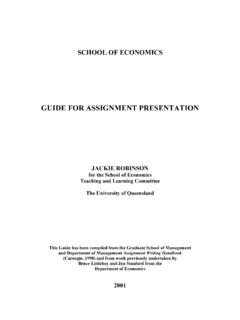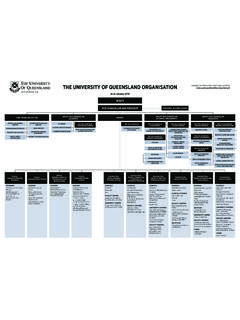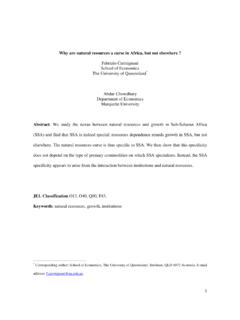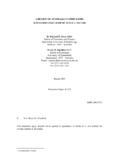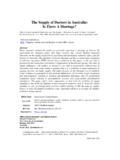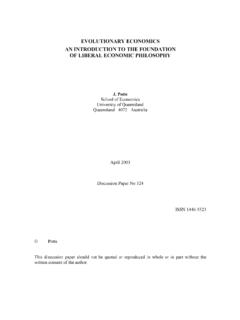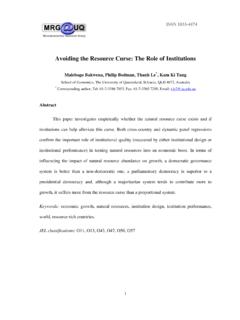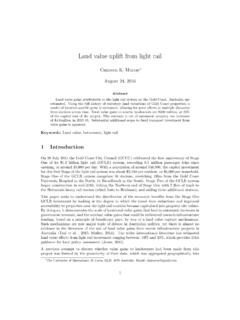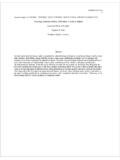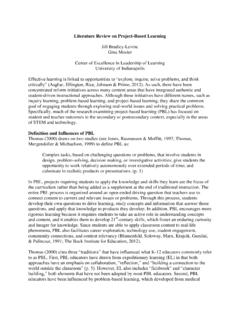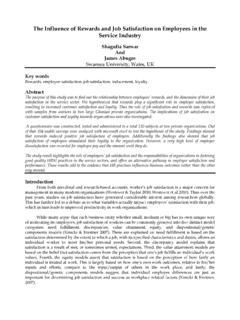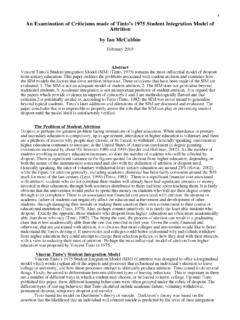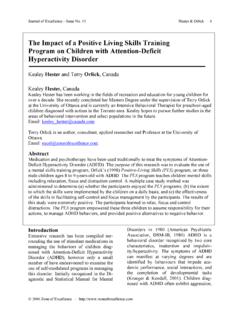Transcription of Electricity Networks Privatization in Australia: An ...
1 1 Electricity Networks Privatization in Australia: An Overview of the Debate Rabindra Nepal* and John Foster** School of Economics University of Queensland St. Lucia QLD 4072 Abstract The debate on Electricity Networks Privatization in the Australian National Electricity Market is an important public policy concern but remains unsettled. This article reviews and compares the economic performance between the privately and state-owned Electricity Networks in Australia across three dimensions encompassing prices, quality and investment. The comparative analysis suggests that privately owned Networks are not worse off than the state-owned Networks in terms of performance. However, international empirical evidences indicate that the efficiency gains to consumers from Electricity Networks Privatization will depend on the underlying regulatory regime and regulatory institutional framework.
2 The long-term concerns on future investments, security of supply, climate change and economic regulation of Networks will continue to prevail once the short-term efficiency gains from Privatization are exhausted. These concerns imply that the role of the state will still be significant, although transformed, even after Electricity Networks Privatization raising questions on the motives of Privatization . * Corresponding author. School of Economics, University of Queensland, St. Lucia, Queensland 4072 Australia. Email: **School of Economics, University of Queensland, St. Lucia, Queensland 4072, Australia. Email: Acknowledgements: We are grateful to the comments received from John Quiggin in improving this paper. 2 1. Introduction The Privatization of the Electricity sector remains an important public policy matter in Australia.
3 The political and economic appeal of Electricity network Privatization has received renewed attention in Australia as the state governments of Queensland (QLD) and New South Wales (NSW) announced further Electricity privatizations if re- elected in 2014 (Chester, 2015). The major rationale for privatizing Electricity Networks involves recycling publicly owned assets to fund other infrastructure sectors such as transport, delivering lower consumer Electricity prices and providing greater quality of service by improving network companies efficiency (Productivity Commission, 2014)1. Significant gaps in the performance of state- owned corporations and privately owned network companies in the Australian National Electricity Market (NEM) have also motivated the Privatization debate (Productivity Commission, 2013).
4 A backlash against the privatisation agenda reflected by the results of recent elections in QLD and the soaring Electricity and gas disconnections in Victoria (VIC) confirms that Electricity privatisation is far and away the most important policy issue in Australia. However, the political and economic concern on Electricity Networks Privatization continues to be debated among academics and policymakers without any clear consensus emerging on the benefits of Privatization . Studies advocating Electricity Privatization have often pointed to the Privatization of the Victorian Electricity assets over the 1990s as a successful example of the productivity enhancing benefits of micro- economic reform (Moran, 2008).
5 The Privatization of the Victorian Electricity industry is also considered to have been a successful fiscal initiative, which rescued the state government from unsustainable debts while increasing expenditure and employment levels in education, health care, and law and order (Abbott, 2007). Victoria corporatized and privatized its Electricity Networks between 1995 and 1999 after the Kennett government functionally unbundled the state Electricity commission in 1994. Likewise, Electricity Privatization in South Australia 1 Under capital recycling, the proceeds from Privatization are channeled towards the procurement of new infrastructure.
6 Retail Electricity prices have gone up about 50 percent over the last four years in Australia (Nepal et al. 2014). 3 occurred during 1999- 2000 implying that the Australian state governments embarked on Privatization programs to different extent since the 1990s. In contrast, studies opposing Electricity Privatization have criticized the same free market models of Electricity supply in Victoria attributing to a record of failures in improving Electricity affordability and reliability over 20 years of reforms (Quiggin, 2014). The transmission and distribution Networks remain state- owned in Tasmania (TAS), NSW, QLD and part of the Australian Capital Territory (ACT). A rapidly growing number of households are suffering from energy impoverishment caused by escalating Electricity prices in Victoria contradicting the proclaimed benefits of lower Electricity prices from the restructuring and privatisation of the Electricity sector (Chester, 2014).
7 Moreover, the Privatization of the network segments needs to be understood differently from other segments of the Electricity supply industry (ESI) given its distinct economic characteristics. Electricity Networks exhibit natural monopoly characteristics such as economies of scale, economies of scope and economies of densities due to high sunk costs and low marginal network operating costs (Kahn, 1971). In practice, entry to network businesses is restricted and economic regulation is required to minimize the inefficiencies and rent seeking associated with monopoly pricing. In the Australian context, economic regulation of Electricity Networks involves different incentive regulation (or price control) regimes across the network segments.
8 For example, the Australian Energy Regulator (AER) determines the maximum revenue (revenue caps) that the transmission companies can recover from the network users and sets the maximum prices that Electricity distribution companies can charge to consumers (price caps) (AER, 2013)2. However, the empirical evidence and discussions on privatizing a regulated natural monopoly such as Electricity network infrastructure remain relatively unexplored and debated in the economics literature, especially in the Australian context. 2 In QLD, ACT and TAS, distribution Networks are regulated using revenue caps while weighted average price caps are used in NSW, VIC and SA.
9 4 The purpose of this article to provide an overview of the academic and policy debate surrounding the Privatization of Electricity Networks in the NEM as previous Electricity Privatization studies in Australia have focused mostly on the Electricity generation segments. We derive relevant policy lessons for Australia based on the international empirical evidences considering Electricity Networks Privatization as an important public policy. This is important as misguided and overlapping policy failures are perceived to be the primary causes of inefficiency in the NEM (Simshauser, 2014). Hence, the article aims to guide policymaking and also contribute to the limited literature on the Privatization of a regulated natural monopoly, in the context of the NEM.
10 The remainder of the paper is structured as follows. Section 2 provides a brief overview of the important academic literature on the economics of Privatization in general and utilities Privatization in particular. Section 3 is a literature review of the existing international empirical evidence on the success and failure of Electricity Networks Privatization . The economic components of costs, quality, pricing and investment performance of the regulated public and private network companies in the NEM are analyzed in section 4. The findings and relevant policy considerations are outlined and discussed in section 5. Section 6 concludes the paper. 2. Review of the academic Literature The academic literature on the theory of Privatization is copious and forms a subset of a large literature on the economics of ownership and the role for government ownership of productive resources (Megginson and Netter, 2001; Muhlenkamp, 2013).
